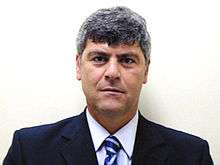Ministries of the Argentine Republic
The Ministries of the Argentine Republic, which form the cabinet, currently consist of sixteen ministries under a ministerial chief of staff.[1] The ministers are appointed by and serve at the pleasure of the president.[1] The current organization derives from the constitutional revision of 1994,[1] and is governed by "The Law on Ministries".[2]
History
Prior to independence, the administration of the Viceroyalty of the Río de la Plata was organized under the Royal Ordinance of Administrators issued 28 January 1782 (la Real Ordenanza de Intendentes),[3] under which there were eight intendencias[4] each with a governor reporting to the viceroy. The governor had the police, finance and the military under his direct control, and his lieutenant administered the courts.[3] At first the revolutionaries retained the same system, only gradually dispersing the executive authority over a larger body of men.[3] The first true cabinet posts in Argentina emerged in the mid 1800s first under various caudillos such as Saavedra and de Rosas and then under the Argentine Confederation and the State of Buenos Aires. For example, the Department of Governance and War (Departamento de Gobierno y Guerra) was created on 28 May 1810 by the First Junta with Mariano Moreno as secretary,[5] and although the First Junta sent out diplomates as early as 1810, it was not until 27 February 1813 that the Department of Foreign Business (Departamento de Negocios Extranjeros) was created under the supervision of the Secretary of State.[6]
- Argentine Confederation (1831 to 1852)[7]
- Ministry of War and the Navy
- Ministry of Finance
- Ministry of Interior
- Ministry of Foreign Affairs
- Ministry of Justice, Religion and Public Education
- State of Buenos Aires (1852 to 1861)[7]
- Ministry of Governance
- Ministry of War
- Ministry of Finance
- Ministry of Foreign Affairs
- Prosecutor's Office
Current ministries
| Ministry | Website | Post | Incumbent | Image | Appt. date |
|---|---|---|---|---|---|
Jefatura de Gabinete de Ministros  | http://www.jgm.gov.ar | Chief of the Cabinet of Ministers | Marcos Peña |  | 10 December 2015 |
| Ministerio de Relaciones Exteriores, Comercio Internacional y Culto | http://www.mrecic.gov.ar | Minister of Foreign Affairs and Religion | Susana Malcorra |  | 10 December 2015 |
Ministerio de Hacienda y Finanzas Públicas  | http://www.mecon.gov.ar | Minister of the Economy and Public Finance | Alfonso Prat-Gay |  | 10 December 2015 |
Ministerio de Defensa  | http://www.mindef.gov.ar | Minister of Defence | Julio Martínez | 10 December 2015 | |
Ministerio de Justicia y Derechos Humanos  | http://www.jus.gov.ar/ | Minister of Justice and Human Rights | Germán Garavano |  | 10 December 2015 |
Ministerio de Seguridad  | http://www.minseg.gob.ar | Minister of Security | Patricia Bullrich | .jpg) | 10 December 2015 |
Ministerio del Interior y Transporte  | http://www.mininterior.gov.ar | Minister of Interior and Transport | Rogelio Frigerio | .jpg) | 10 December 2015 |
| Ministerio de Trabajo, Empleo y Seguridad Social | http://www.trabajo.gob.ar | Minister of Labour, Employment and Social Security | Jorge Triaca Jr. | 10 December 2015 | |
Ministerio de Salud  | http://www.msal.gov.ar | Minister of Health | Jorge Lemus | .jpg) | 26 February 2015 |
Ministerio de Educación  | http://www.educacion.gob.ar | Minister of Education | Esteban Bullrich |  | 10 December 2015 |
Ministerio de Ciencia, Tecnología e Innovación Productiva  | http://www.mincyt.gob.ar | Minister of Science, Technology and Product Innovation | Lino Barañao |  | 10 December 2007 |
Ministerio de Desarrollo Social  | http://www.desarrollosocial.gov.ar | Minister of Social Welfare | Carolina Stanley | 10 December 2015 | |
Ministerio de Producción  | http://www.industria.gob.ar | Minister of Industry | Francisco Adolfo Cabrera |  | 10 December 2015 |
Ministerio de Agricultura, Ganadería y Pesca  | http://www.minagri.gob.ar | Minister of Agriculture, Ranching, and Fishing | Ricardo Buryaile |  | 10 December 2015 |
Ministerio de Turismo  | http://www.turismo.gov.ar | Minister of Tourism | Gustavo Santos | 10 December 2015 | |
| Ministerio de Cultura | http://www.cultura.gob.ar | Minister of Culture | Pablo Avelluto | 10 December 2015 | |
| Ministerio de Energía y Minería | http://energia.gob.ar | Minister of Energy and Mining | Juan José Aranguren | 10 December 2015 |
Notes and references
- 1 2 3 "Jefatura de Gabinete de Ministros". Jefatura de Gabinete de Ministros. Archived from the original on 10 April 2015.
- ↑ La Ley de Ministerios, The Law on Ministries was established by Decree 438 of 1992, and amended by Law 26638, promulgated on 6 December 2007.
- 1 2 3 Zabala, Juan Pablo; Departamento Documentos Escritos, División Nacional (2012). Fondos documentales del Departamento Documentos Escritos, División Nacional: Programa de Descripción Normalizada: secciones gobierno, Sala X y contaduría, Sala III, tribunales y protocolos de escribanos: volumen 2 (PDF) (in Spanish). Buenos Aires: Archivo General de la Nación, Ministerio del Interior. p. 33. Archived from the original on 16 May 2015.
- ↑ The intendencia were Buenos Aires, San Miguel de Tucumán, Cuyo, Paraguay, Santa Cruz de la Sierra, Potosí, La Paz and Chuquisaca. Kermenic, Jan M. (1993). Pueblos, lenguas e instituciones de América meridional, Tomo I: AA–MM (in Spanish). Lima, Peru: [s.n.] p. 149. OCLC 30746236.
- ↑ Zabala 2012, p. 218
- ↑ Zabala 2012, p. 166
- 1 2 Zabala 2012, p. 26
